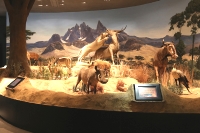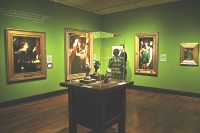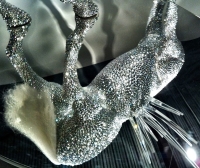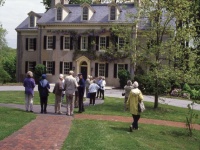City guides


Wilmington Travel Guide
Wilmington has undergone a revitalisation in recent years, and though doing business is perhaps still the main attraction, it's definitely worth a visit. Visitors can stroll along a waterfront path leading to the Shipyard Shops, the rowing centre, and various restaurants and museums.
The city comprises many distinct neighbourhoods, and for those seeking a less touristy experience, Trolley Square is an excellent option. It's full of sidewalk cafes, cosy bistros, and lively pubs, including Kelly's Logan House which is a local institution since 1864 and by far the best place to be on St Patrick's Day.
Stately old homes and restored townhouses surround the area. Not far away is Little Italy, home to Mrs Robino's, one of the city's oldest and most popular spots for authentic Italian food. During the summer, the best way to cool off is with a treat from one of the historic community's countless Italian water ice stands.
For many visitors, the most appealing attractions lie just outside the city limits in the beautiful Brandywine Valley. The area is a horticultural delight of endless gardens and arboretums, as well as the 'American castles' of the du Pont family, including Winterthur and Nemours, which are magnificently preserved and packed with artwork and antiques.
Things to do in Wilmington
Wilmington is midway between New York and Washington DC, so it's perfectly situated for a weekend getaway or stop-over. In addition, it's full of undiscovered gems, such as the Mt Cuba Center's indigenous gardens, which makes it an ideal setting for a romantic holiday. The Brandywine Valley is lovely for couples, though its many museums cater to children as well.
Wilmington holds some treasures for art lovers, with the Delaware Art Museum and the Delaware Contemporary both highly regarded. History buffs should find something of interest in the Hagley Museum and Library, and the Delaware History Museum.
For those keen to discover some of the stately old homes of the region, the Nemours Mansion is in Wilmington and offers tours of the estate and gardens, and the Winterthur Museum, Garden, and Library, another du Pont mansion, is nearby.
Sports fans may want to catch a game at Frawley Stadium, and the Grand Opera House is an impressive venue for the performing arts. Those looking for a taste of Delaware's scenic beauty within the city limits should visit the Alapocas Run State Park or the Brandywine Creek State Park.

Delaware Museum of Natural History
Featuring some fantastic exhibits, the Delaware Museum of Natural History is a great attraction for visitors of all ages and persuasions. The dinosaur gallery is a favourite with most visitors, with Tuojiangosaurus and Yangchuanosaurus skeletons towering over awe-inspired visitors. Anyone who stops by should absolutely view the Elephant Bird egg in the Hall of Birds; admire animals from around the world in the Hall of Mammels; or explore the Shell Gallery, which boasts an impressive collection of two million shells. In addition to the permanent exhibits, there are constantly changing special exhibits on display, tours, and interactive outdoor experiences.

Delaware Art Museum
Holding a collection of more than 12,000 works, the Delaware Art Museum was founded in 1912 by the Wilmington Society of Fine Arts in honour of the artist Howard Pyle, whose painting 'Battle of Bunker Hill' was in the museum's possession until it went missing and was presumed stolen in 2001. Apart from the remaining works of the much-loved local artist Howard Pyle, and some of his American contemporaries, the museum is perhaps best known for its extensive collection of British Pre-Raphaelite art. The urban landscapes of John Sloan can also be viewed here. Temporary exhibitions are hosted regularly and public and group tours of the museum are available.

The Delaware Contemporary
The state's only museum solely dedicated to contemporary art, the Delaware Center for the Contemporary Arts (now usually just called the Delaware Contemporary), features displays of local, regional, and international artists in its seven galleries. It also features about 26 artists' studios, a gift shop, a high-tech auditorium, and a classroom where workshops and lectures are held. The museum is best known for its challenging and intriguing exhibitions, which are curated to be relevant and topical. The fact that admission is free is an extra incentive for visitors with time to kill in the city, and the quick turnover of art on display ensures that there's always something new to see.

Hagley Museum and Library
The Hagley Museum and Library collects, preserves, and interprets the history of American enterprise and is a non-profit educational institution. With a range of exhibitions, guided tours, walking trails, and demonstrations, there's so much to learn at the Hagley Museum. Visitors can experience 19th-century living on Workers' Hill, visit the Powder Yard, where massive stone mills, storehouses, and a waterwheel echo a time when water was the main source of energy, and tour the Eleutherian Mills, a mansion that has been home to five generations of the famous du Pont family and features breath-taking views over the Brandywine Valley.
Wilmington Climate and Weather
Wilmington has a humid subtropical climate, with cool winters and hot, humid summers. Average winter temperatures range between 50°F (10°C) and 65°F (18°C), while summer temperatures average a balmy 80°F (27°C) to 90°F (32°C). Spring is warm and mild, with the many gardens of the Brandywine Valley bursting into bloom, and visitors should note that often rooftops and cars can be turned yellow due to the pollen dusting during the season.
United States of America travel info
Electricity
The electrical current is 120 volts, 60Hz. Plugs are mainly the type with two flat pins, though three-pin plugs (two flat parallel pins and a rounded pin) are also widely used. European appliances without dual-voltage capabilities will require an adapter.
Language
English is the most common language spoken but Spanish is often heard in the south-western states.
Money
The official currency is the US Dollar (USD), which is divided into 100 cents. Only major banks exchange foreign currency. ATMs are widespread and credit cards are widely accepted; Apple Pay and Google Pay are very popular. Banking hours are Monday to Friday 9am to 3pm.
Tipping
A 15 percent tip is expected by taxi drivers, bartenders, hairdressers and waiters, but travellers shouldn't tip in fast-food or self-service restaurants. In expensive restaurants or for large parties, the tip should be 20 percent of the bill. It's normal to tip staff such as valets and porters in hotels; this is discretionary, although a minimum of $5 is expected. Most services are customarily tipped if the service is good.
Health
There are no specific health risks associated with travel within the USA. Medical facilities are excellent, but expensive. Only emergencies are treated without prior payment and treatment can be refused without evidence of insurance or proof of funds. Good medical insurance is essential.
Safety
Travel within the United States is generally trouble-free, though travellers should be aware that the US shares with the rest of the world an increased threat from terrorist incidents. Security has been heightened, particularly at airports. Restrictions on hand luggage apply and travellers are advised to check on the latest situation with airlines in advance. Travellers should also be alert to the dangers of car and street crime in cities and should use common sense and take basic precautions. Hurricanes are common between June and November, putting the southern USA, including the Gulf Coast and the eastern US at risk. There's a risk of wildfires in many dry areas in the US, particularly on the West Coast from March to November.
Local customs
Laws vary from state to state, including speed limit, fines and punishment. The age at which alcohol may be legally bought and consumed is 21 years.
Doing business
In such a large country, filled with so many diverse groups, business practices may differ according to each state, though rarely to any large degree. The East Coast is traditionally more formal than the West Coast, though in states such as California, dress code and conservative appearance are as common as they would be in New York. Punctuality is important throughout the country and it's considered rude to be late for a meeting. Gift-giving is uncommon as it may be construed as bribery. Appropriate titles (Mr, Mrs, Ms) are used upon introduction and until otherwise stated. Americans favour politeness and greetings of 'Hello' and 'How are you?' are often expressed with sincerity. Business hours may vary in each state, but an 8am start and 5pm finish Monday to Friday is the most common with an hour over lunch.
Status and age are not necessarily indicative of seniority, nor do they carry much weight in themselves. Those doing business in the States should be mindful of this fact; foreigners should never make assumptions about someone's position or rank. Best practice is to be respectful to all parties. That said, the US upholds a hierarchal business structure in which 'the boss' is the ultimate decision-maker. Senior leaders have the power of the last word, and can go against the grain just as easily as they can follow popular opinion. Foreigners should concentrate on winning over this individual, even if the greater group seems unsupportive. Americans value a direct style of communication. In this fast-paced, consumer culture 'time is money', and small-talk is viewed as unnecessary and wasteful. It's best for foreigners to get to the point quickly, speak about issues in a frank and open manner, and to avoid taking offence if someone questions or challenges them outright.
Duty free
Travellers to the United States who are returning residents of the country do not have to pay duty on articles purchased abroad to the value of $800 provided their stay was longer than 48 hours and their duty-free allowance was not used in the 30-day period prior. For passengers arriving from Samoa, Guam and the U.S. Virgin Islands, a duty-free allowance of $1,600 is allowed. The following items are included in this: 50 cigarettes and 10 cigars and 150 millilitres (5 fl. oz.) of alcoholic beverages or 150 millilitres (5 fl. oz.) of perfume containing alcohol. Restrictions may apply to goods from Cuba, Iran, North Korea, Burma (Myanmar), Angola, Liberia and Sudan. It is prohibited to import Cuban cigars from any country.
Travellers to the United States who are non-residents do not have to pay duty on the following items: 50 cigars or 200 cigarettes and gifts to the value of $100 provided their stay in the USA is not less than 72 hours and that the allowance has not been used in the preceding six-month period.
Prohibited items for residents and non-residents include meat or meat products, poultry, narcotics, absinthe, plants, seeds, vegetables, fruits, soil, live insects and other living plants or animal pests. Fish is prohibited unless it carries disease-free certification. Wildlife and animals or their by-products carry restrictions. Dairy products and eggs from specified countries are not allowed. Firearms and ammunition are not allowed without the necessary license and permit.
Communications
The international country dialling code for the United States is +1. Mobile networks cover most of the country, especially all urban areas; travellers can purchase local prepaid SIM cards for unlocked phones or use eSIMs if their cellular providers support it on their networks. WiFi is widely available.
Passport & Visa
It is highly recommended that travellers' passports have at least six months' validity remaining after the intended date of departure from them travel destination. A visa is required for short visits unless travellers qualify for entry under the Visa Waiver Program.
The Visa Waiver Program (VWP) enables citizens of certain countries to travel to the US for a stay of up to 90 days without a visa. Visitors under the VWP need a valid Electronic System for Travel Authorization (ESTA), which allows the US government to screen all visitors before travel. Visitors entering the country under the VWP must have a machine-readable passport (MRP) that has a barcode on the photo page. Travellers under the VWP must have passports that include biometrics if they wish to enter the country without a visa, which means that passports must contain unique personal data such as fingerprints or iris details. All passports must contain a digital photo image in order to travel visa-free. All visitors to the USA have a photograph and two fingerprints taken by an inkless scanner on arrival, including those travelling visa-free under the VWP.
As part of the Western Hemisphere Travel Initiative (WHTI), all travellers travelling between the United States and Canada, Mexico, Bermuda, and the Caribbean region are required to present a passport or other valid travel document to enter or re-enter the United States. If departing from the USA, a valid passport is required by immigration authorities. Immigration officials often apply different rules to those stated by travel agents and official sources.
Entry requirements
US citizens require passports.
UK nationals require a passport valid for duration of stay. Most passport holders can get an Electronic System for Travel Authorisation (ESTA) through the Visa Waiver Programme, which allows travel to the US for up to 90 days. The VWP includes tourism, certain types of business visit and transit to another country.
The most important requirement on entering the U.S. is providing proof of Canadian citizenship. A valid Canadian passport is the best document to prove Canadian citizenship and the right to return to Canada. However, several other documents can serve, depending on the mode of transport. Generally, Canadian citizens do not require visitor, business, transit or other visas to enter the United States from Canada, though there are some exceptions.
Passports must be valid for the period of intended stay. If visiting the US for fewer than 90 days, Australian nationals may be eligible to apply for an Electronic System for Travel Authorization (ESTA), and enter under the Visa Waiver Program (VWP).
South Africans must hold a passport valid for duration of stay. A visa is required.
Passports must be valid for duration of stay. Irish nationals can get an Electronic System for Travel Authorisation (ESTA) under the Visa Waiver Programme for entry into the United States.
Passports must be valid for duration of stay. New Zealand nationals can get an Electronic System for Travel Authorisation (ESTA) under the Visa Waiver Programme for entry into the United States.
Useful contacts
United States Tourist Office: www.usatourist.com
911 (General)Embassies / consulates in other countries
United States Embassy, London, United Kingdom: +44 20 7499 9000.
United States Embassy, Ottawa, Canada: +1 613 688 5335.
United States Embassy, Canberra, Australia: +61 2 6214 5600.
United States Embassy, Pretoria, South Africa: +27 12 431 4000.
United States Embassy, Dublin, Ireland: +353 1 668 8777.
United States Embassy, Wellington, New Zealand: +64 4 462 6000.
Embassies / consulates in United States of America
British Embassy, Washington DC: +1 202 588 6500.
Canadian Embassy, Washington DC: +1 202 682 1740.
Australian Embassy, Washington DC: +1 202 797 3000.
South African Embassy, Washington DC: +1 202 232 4400.
Irish Embassy, Washington DC: +1 202 462 3939.
New Zealand Embassy, Washington DC: +1 202 328 4800.


